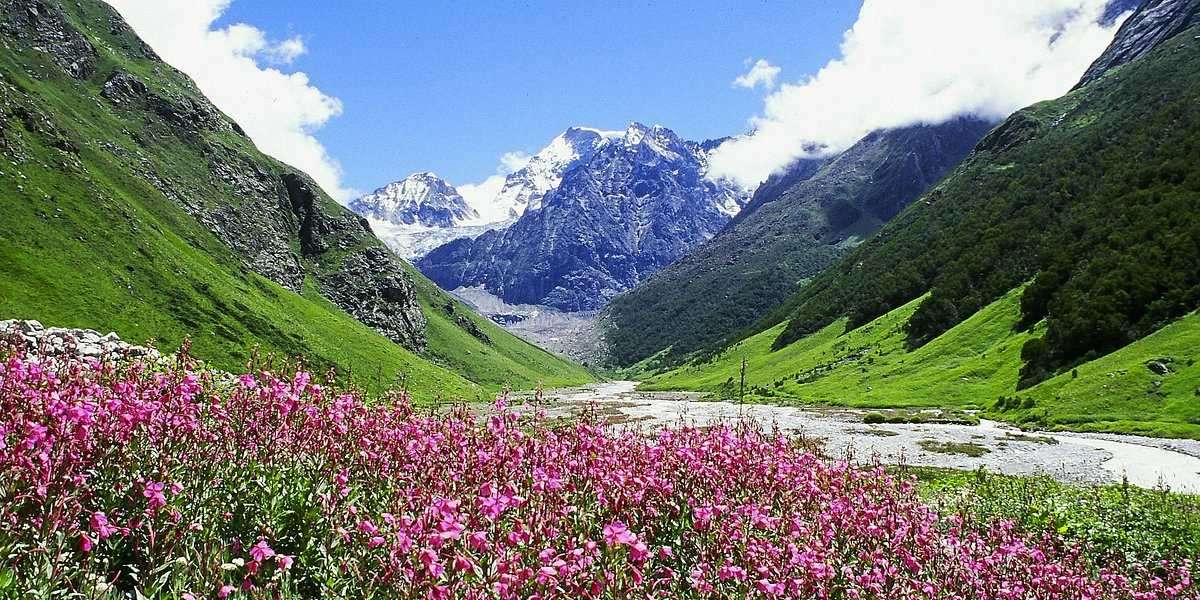Valley of Flowers, located in Uttarakhand, India, is a picturesque destination that is
often overlooked by tourists.
It is an adventurer#39;s paradise, with its breathtaking natural beauty and rugged terrain.
Indian national park Valley of Flowers National Park was founded in 1982. It is famed
for its meadows of endemic alpine flowers and the variety of flora and is situated
near Chamoli in the state of Uttarakhand. In addition to being home to a wide variety
of rare and endangered species, this region is also home to the Asian black bear,
red fox, snow leopard, musk deer, brown bear, and blue sheep. The park is also
home to Himalayan monal pheasants and other high-altitude species.
The valley is nestled in the Chamoli district of Uttarakhand, at an altitude of 3,658
meters above sea level. It is a part of the Nanda Devi Biosphere Reserve, a
UNESCO World Heritage site. The valley is famous for its alpine flowers, which
bloom from June to October. The flowers carpet the entire valley, turning it into a
paradise of colors and fragrances.
UNESCO designated the Valley of Flowers as a World Heritage Site. It was inscribed
on the list in 1988 as a part of the Nanda Devi National Park and Biosphere Reserve.
The park includes the Valley of Flowers as well as the Nanda Devi sanctuary and is
home to a diverse range of flora and fauna, including several endangered species.
The area has been protected since 1982, and the UNESCO designation helps to
preserve the natural beauty of the valley and promote sustainable tourism in the
region. The Valley of Flowers is a unique ecosystem and is an important site for
ecological and scientific research. It is also a popular destination for trekking and
adventure tourism, attracting thousands of visitors every year.
To reach the Valley of Flowers, one has to trek for 17 km from Govindghat, the base
camp. The trek is not easy, but the scenery along the way is worth the effort. The
trail winds through dense forests, gushing streams, and towering mountains. As you
ascend higher, the air gets thinner, and the scenery becomes more spectacular.
Once you reach the valley, you are greeted with a view that is beyond words. The
valley is an explosion of colors, with more than 300 species of flowers blooming all
around you. The most commonly found flowers are Himalayan blue poppy,
Himalayan bellflower, Himalayan cobra lily, and Himalayan knotweed.
Apart from flora, the valley is also home to a variety of wildlife. You might come
across animals like musk deer, snow leopard, Asiatic black bear, and Himalayan
tahr. Birdwatchers will also be delighted to spot birds like Himalayan monal, golden
eagle, and Himalayan snowcock.
The national Ministry of Environment and Forests of India#39;s Uttarakhand State
Forestry Department is in charge of managing the park. The national park is
uninhabited, and grazing has been prohibited there since 1983. Throughout the
summer, from June to October, the park is only open for 4 to 5 months.
The Valley of Flowers has gained importance since it reflects the diverse alpine flora
of the Western Himalayan alpine shrub and meadows ecoregion. The abundance of
species in the valley is a result of its placement in a zone of transition between the
Eastern and Western Himalayan floras and the Zanskar and Great Himalayan
mountains to the north and south, respectively. Many plant species are thought to be
under danger. There are a few that have not been reported outside of Uttarakhand.
Two haven#39;t been noted in Nanda Devi National Park. Records indicate that there
are more endangered plant species here than in other Indian Himalayan protected
areas. The entire Nanda Devi Biosphere Reserve is part of the Western Himalayan
Endemic Bird Region (EBA).
If you are an adventurer, you can explore the valley by trekking to the nearby peaks.
Some of the popular peaks are Nilgiri Parbat, Hanuman Parbat, and Ratban Parbat.
You can also camp in the valley, and experience the thrill of sleeping under the stars.
The best time to visit the beautiful Valley of Flowers is between June to October. The
valley is closed during the winter months due to heavy snowfall. It is also important
to note that the valley is a protected area, and visitors are required to obtain a permit
from the forest department.
In conclusion, the Valley of Flowers is a must-visit destination for adventurers and
nature lovers. It is a place where you can escape the chaos of the city and immerse
yourself in the beauty of nature. So pack your bags, put on your trekking shoes, and
head to Uttarakhand to explore this paradise on earth.






